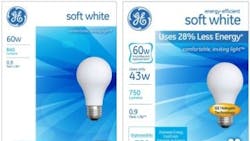Halogen bulbs impersonate incandescents
Consumers who are miffed about losing access to 60-W incandescent bulbs now have another option. Actually, it has been there all along but is being repackaged and remarketed: GE is currently re-introducing its halogen bulbs under the Energy-Efficient Soft White label long associated with its incandescent bulbs.
This namesake was intentionally chosen to convey the similarities between incandescent and halogen technologies. It would be easy to mistake the two kinds of bulb at first glance -- the color of their light is quite similar and the two are nearly the same brightness. In fact, consumers who don't look closely at the packaging may not be able to tell they are really getting a halogen bulb, except for the words "Uses 28% less energy" printed on the halogen version. The point GE hopes to convey is that consumers they won’t lose anything by making a switch from standard incandescents – they’ll just save more in efficiencies.
Assuming, of course, consumers understand that there is a difference between incandescent and halogen technology.
GE’s Energy-Efficient Soft White bulb has a tungsten filament like the incandescent bulb, but is filled with halogen gas. When the bulb lights, tungsten from the filament evaporates inside the bulb, providing illumination while letting the bulb last longer. The halogen gas then carries the evaporated tungsten particles back to the filament and re-deposits them. This gives the Energy-Efficient Soft White bulb a longer life than traditional incandescent bulbs.
The GE bulbs sit in A-line shells that look just like those of incandescent bulbs and are fully dimmable. And unlike CFLs, halogen bulbs start instantly. The warm white light they put out is close to that of incandescents but they run no hotter.
Traditional incandescent bulbs last up to 1,000 hours, and the halogens last as long or longer. The GE bulb comes in 29-,43-,53- and 72-W varieties that replace 40-, 60-, 75- and 100-W incandescents, respectively. They are offered in Clear, Reveal, Soft White or Soft White Reveal styles.
Here's a link to the GE announcement which contains a video of GE personnel basically saying the same things you can read in the announcement: http://pressroom.geconsumerproducts.com/pr/ge/upgrade-to-ge-s-energy-efficient-235481.aspx
